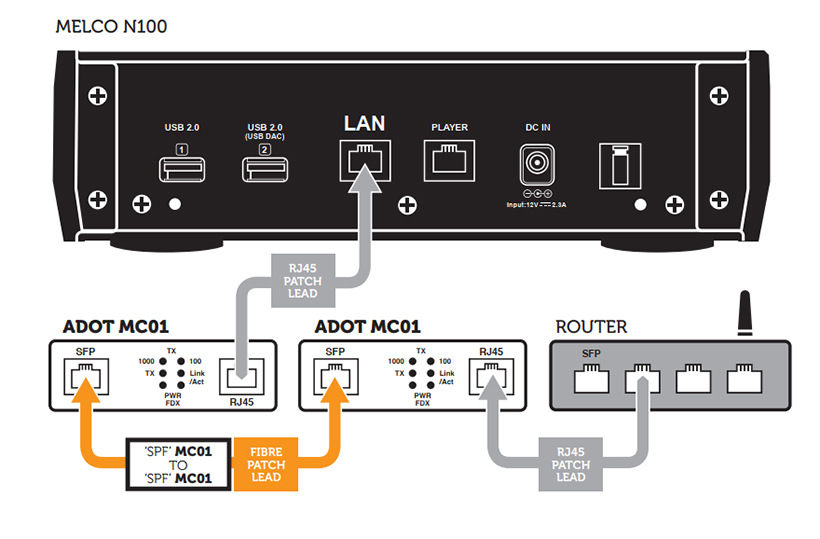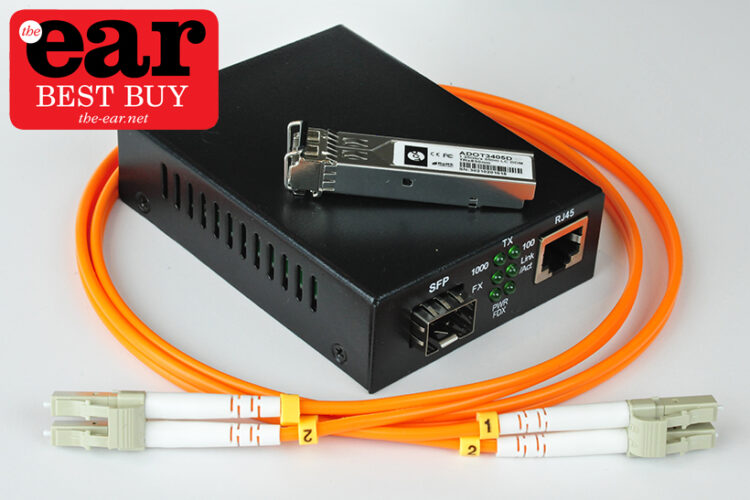There is more than one way of getting data from A to B as Openreach employees know only too well, they are the people who are changing the copper wire connections installed for telephone landlines (and invaded for internet) to fibre optic cables that are capable of significantly higher bandwidth and speed. Inside the home there are essentially two options for internet data transmission, ethernet cable or Wi-Fi. Both are up to the task of getting music from a server to a streamer but the cable option is the most reliable and favoured by anyone who wants to eliminate problems from their streaming experience.
It is also possible to route data via fibre optic cables in the home, some have been doing this for a while because it looks like a great way of isolating a streaming system from the noise that pollutes a regular network. Melco even make a network switch that has an SFP fibre optic ready connection in the S100 that made such a positive impression on us last year.
It won’t come as much of a surprise to discover that the Melco distributor is offering fibre optic kits that provides all the elements required to isolate an ethernet streaming network. ADOT or Audiophile Digital Optical Technology make a compact fibre optic to ethernet transceiver called the MC01 that will convert both fibre to ethernet and back again. This means that if you have two of them and connect one to the router by ethernet then link it to a another MC01 with fibre optic cable the ethernet output of that second MCO1 goes to the network switch or straight into your music server. It’s easier to understand if you look at the graphic below, essentially all that’s happening is that the copper wire link between the router and music server (represented by a Melco N100) is being replaced with something less able to transmit noise.

The benefits of fibre are greater than you might imagine, in the first instance the absence of metal provides full galvanic isolation, which means that no electrical current can flow and data is transmitted optically. The other benefit is that the data stream is reconstructed and retimed at the receiver which reduces both jitter and noise. ADMM created the ADOT MCO1 media converters with the option of slowing down the throughput via dipswitches, thus although it is capable of gigabit speeds it sounds best at 100Mb/s. This is a popular approach at Melco whose media servers operate at slower speeds in order to reduce noise, they argue that avoiding high speed hard drives leads to higher sound quality. My one criticism of the ADOT package is that the MC01 units as supplied need their settings adjusted to achieve this forced slowing of data rates, there is a sticker on the unit but that didn’t turn out to be fool proof in this instance…
One strange thing about fibre connections is that the plugs on the ends of cables cannot be directly connected to the SFP (small form plug) ports on the MC01, they require an SFP adapter and this is another potential weak link. Most such adapters are designed for speed, not what’s needed in this application, so selecting the right one therefore requires a bit of expertise. Even the fibre itself is not a simple choice of length as there are several varieties, ADMM provide multimode fibre which works best at lengths of 1.5m or more and this is what was used for the review.

Slightly confusing is that this kit is only appropriate if your network switch has an SFP input, which includes the Melco S100 and a few other audio oriented switches. If you have a normal data switch or a direct link to the router then you need a second MC01 to convert the fibre back to ethernet. In my system an English Electric 8Switch connects both the streaming system and the PC to the router so it was important to isolate the server and streamer from the switch. I put two MC01s connected by fibre in between the switch and the server and connected the latter directly to the streamer, which is the way it normally runs and sounds best.
The other factor when choosing a fibre converter is the power supply. Like everything else in an audio system power supplies play a significant role in sound quality, in general terms the cleaner the supply the better the sound. The base Kit 1 comes with a switched mode supply (SMPS) but Kit 2 upgrades this to a linear supply (LPS) based on an EI transformer, it’s still a plug-top type but will deliver a better result if past experience is anything to go by. The top option is found in Kit 3 where you get a Plixir LPS with three stage noise reduction and a nice bit of casework, I tried one with the Melco N100 server in the past and the benefits were obvious. Fortunately you don’t need two power supplies to run two MCO1 converters as the PSU’s 5V output can be split and shared by both
Sound quality
As this kit is supplied by the Melco distributor I decided to rebel and use it with an Innuos Zenith SE server which like the Melcos has a player output for ethernet to the streamer, which in this instance was an Aqua LinQ (watch out for a review soon). When playing from the Innuos library, which means the connection to the switch only serves to provide control data not signal, putting the fibre kit in the ethernet line made a clear and significant difference. This took the form of a relaxation in the presentation and an increase in image depth that was very clear, there appeared to be little impact on timing but a distinct sense of extra clarity and reduction in grain. It’s one of those upgrades that you don’t crave until you hear it, if that makes any sense, the sound without the fibre was pretty damn good in the first place but the isolation provided delivers a tangible benefit.

Using the USB output on the Innuos and connecting it directly to a DAC, the LinQ’s partnering La Scala MkII, made the sound much cleaner and had a distinct impact on the sense of timing which moved up a level in no uncertain terms. The sound essentially became more open and clear with less time smear, that is the spaces between the notes were better defined which means that each one stopped and started more precisely yet without any added forwardness or sense of unnatural urgency. Gil-Scott Heron’s New York is Killing Me was revealed to be a better recording than it initially seemed, and it seemed pretty good to begin with.
Moving over to a source outside the room in the form of the Qobuz streaming service where signal is fed through the switch, and continuing with the USB output saw a similar increase in space and air, greater clarity and with it a greater contrast within the music. A piece by jazz guitarist Julian Lage (Familiar Flower) that had caught our attention on the radio in the background but which sounded rather homogenous prior to introducing the fibre break, now it sounded a lot more interesting and revealed why it had piqued interest in the first place.
Moving over to a Melco N10 music library and dropping in the fibre link brought similar rewards to the Innuos with more openness and better timing but the timing aspect became more sophisticated, with lots of subtleties and nuances emerging. It almost seems as if the musicians are playing better and communicating with one another more effectively but this is because there is less time smear in the signal of course, Herbie Hancock and his band (Wayne Shorter, Vinnie Colaiuta, Lionel Loueke, Dave Holland) were very much on their game when they made River: The Joni Letters. As were the Rolling Stones in the early ‘70s, drugs notwithstanding, streaming Can’t You Hear Me Knocking from Qobuz and switching in the fibre delivers more clarity, contrast, energy and pure groove to tremendous effect. It doesn’t have the immediacy that can be achieved with locally stored music but is a strong second best.

As luck would have it an SOtM sNH-10G network switch with SFP connections turned up during the ADOT review, this meant I could remove one MC01 and connect to the switch with fibre. This time around I played Big Yellow Taxi (Joni Mitchell & LA Express, Miles of Aisles) which has rather fudgey bass that’s strong but lacks definition. Connecting an MC01 to the switch with fibre and converting back to ethernet before the server brought about a clear increase in clarity across the board, this revealed shape and punch in the bass that energizes the performance. The top option available with the ADOT kits is the Plixir power supply, using this with the single MCO1 in the arrangement described above and with the same track brought out more openness but was of greatest benefit to the sense of pace, it delivered the immediacy that you get with live music and which gives it drive and vitality. We note that ADOT recommend the switch be isolated from the router rather than the server from the switch but as our switch also connects the PC to the router that source of pollution would remain.
There are many ways of upgrading a streaming system but this undoubtedly one of the best value options. It gives you more bang for your dollar, pound or euro than the alternatives such as cables or a network switch of similar price, albeit a decent cables may be required to fully appreciate what it’s doing. Adding a noise barrier that’s as effective as that provided by the ADOT fibre kit is usually a lot more expensive than this and the benefits it brings to the end result are not subtle in the least, anyone interested in getting more out of their streaming system should investigate forthwith.


